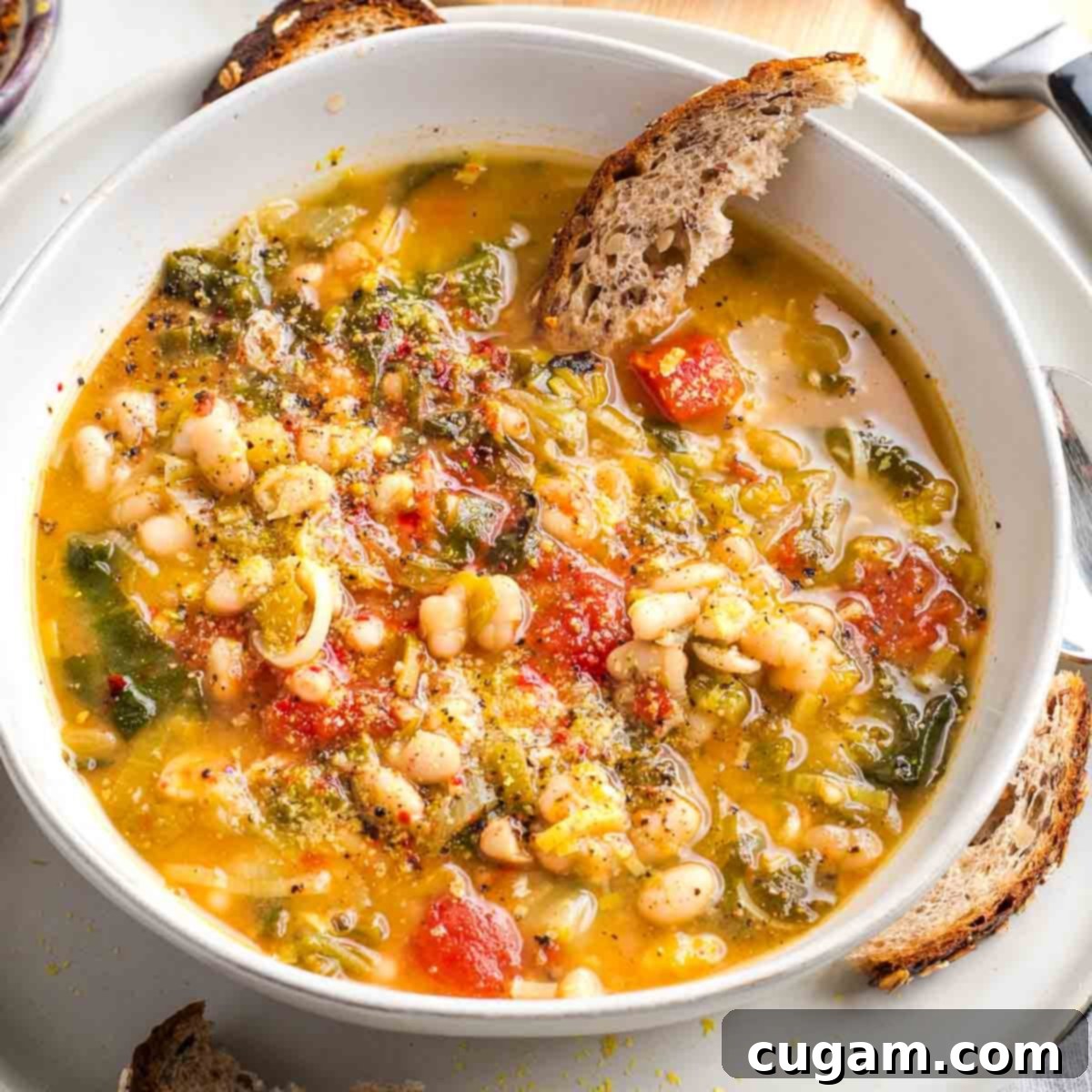Hearty & Healthy Vegan White Bean and Escarole Soup: Easy 30-Minute Recipe
Discover the ultimate comfort food that’s both incredibly satisfying and wonderfully nourishing: this **White Bean and Escarole Soup**. It’s a culinary masterpiece that combines delicious flavors with simple, wholesome ingredients, making it an absolute must-try for anyone seeking a hearty meal, especially during the colder months. This recipe isn’t just easy to make; it’s designed to be a complete, fulfilling meal that will warm you from the inside out and leave you feeling perfectly content. I’ve personally fallen in love with this white bean escarole soup and often feature it as a staple in my winter kitchen rotations.
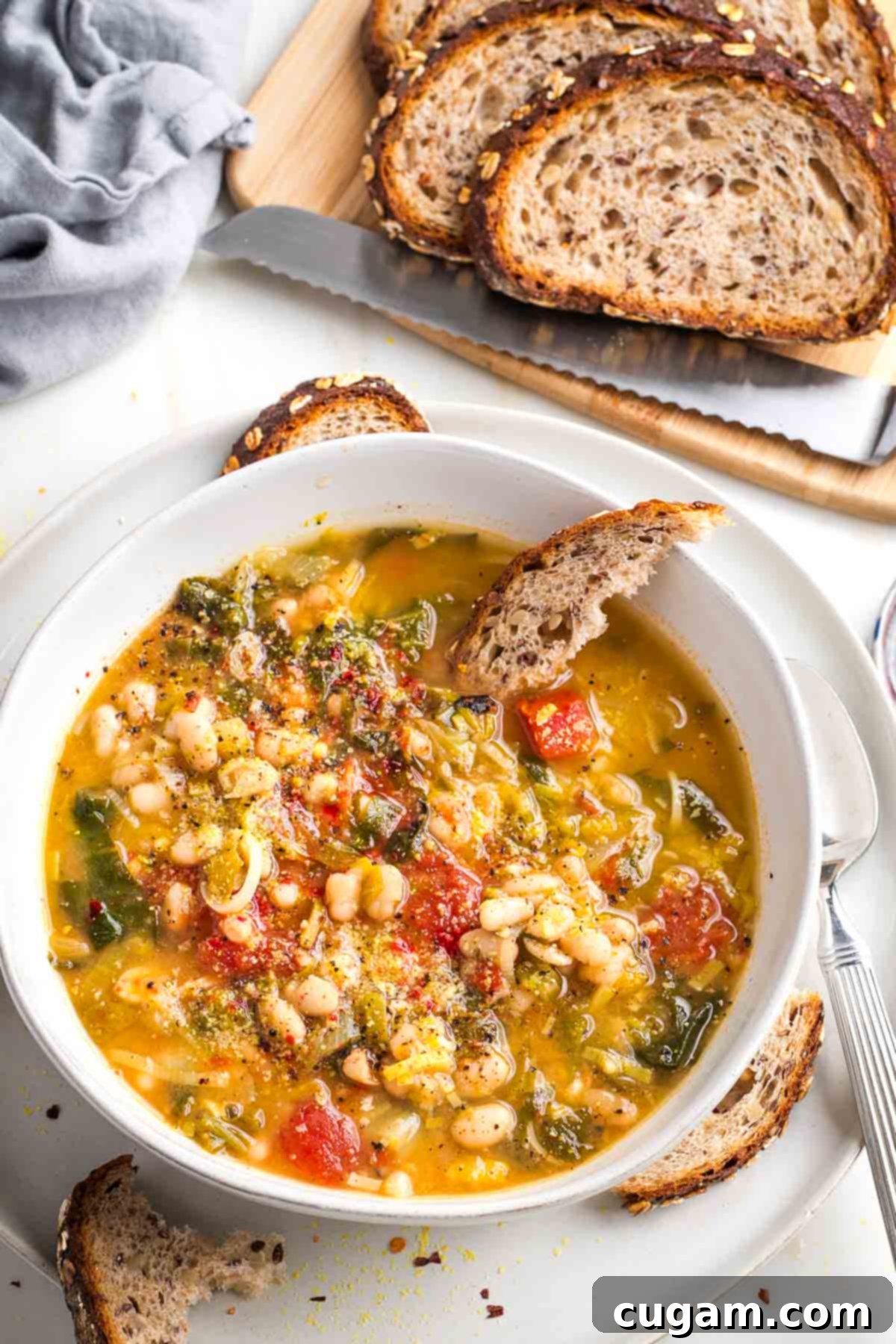
[feast_advanced_jump_to]
Why This White Bean Escarole Soup Will Become Your New Favorite
If you’re looking for a truly comforting, nutrient-dense, and incredibly easy-to-make dish, then this white bean and escarole soup is it. It stands out as the ultimate hearty soup in my repertoire, embodying pure comfort food that surprisingly also happens to be completely vegan and gluten-free. This isn’t just a meal; it’s culinary magic, coming together in under 30 minutes, which is perfect for busy weeknights or when you crave something wholesome without the fuss.
There’s an abundance of deliciousness packed into every spoonful of this white bean soup. White beans, such as cannellini, are true powerhouses of plant-based nutrition. They are an excellent source of protein and fiber, two crucial components that work together to keep you feeling full, satisfied, and energized for longer. This makes the soup not only incredibly tasty but also deeply nourishing, contributing positively to your digestive health and overall well-being. I even use white beans in my creamy vegan tomato soup to add that extra layer of richness and sustenance, proving just how versatile and beneficial they are.
What makes this recipe particularly appealing is its reliance on simple, accessible ingredients that you can easily find at your local grocery store. There’s no need for exotic or hard-to-find items, making it a practical choice for everyday cooking. Just grab a fresh loaf of crusty bread – perhaps a warm baguette or a rustic sourdough – and you’ve got yourself a perfect, complete meal that can be enjoyed any time of day, whether for a quick lunch or a cozy dinner. The combination of wholesome ingredients and minimal prep time makes this soup an indispensable addition to your recipe collection.
My journey to perfecting this recipe actually evolved from a long-standing family favorite: kale and cannellini bean soup. While that was a beloved dish, I eventually discovered the unique charm and fantastic digestive benefits of escarole. Its slightly bitter, yet refreshing, flavor profile, coupled with its tender texture when cooked, completely won me over. So, I experimented, tweaked a few elements, and the rest, as they say, is history. Escarole has since become my preferred leafy green for this type of hearty soup, elevating the dish to a whole new level of flavor and nutritional value. The change was a total revelation, making the old kale version a distant memory.
Essential Ingredients and Smart Substitutions
Creating this flavorful and hearty white bean and escarole soup relies on a handful of fresh, simple ingredients. Here’s a detailed look at what you’ll need and how you can adapt the recipe with easy substitutions:
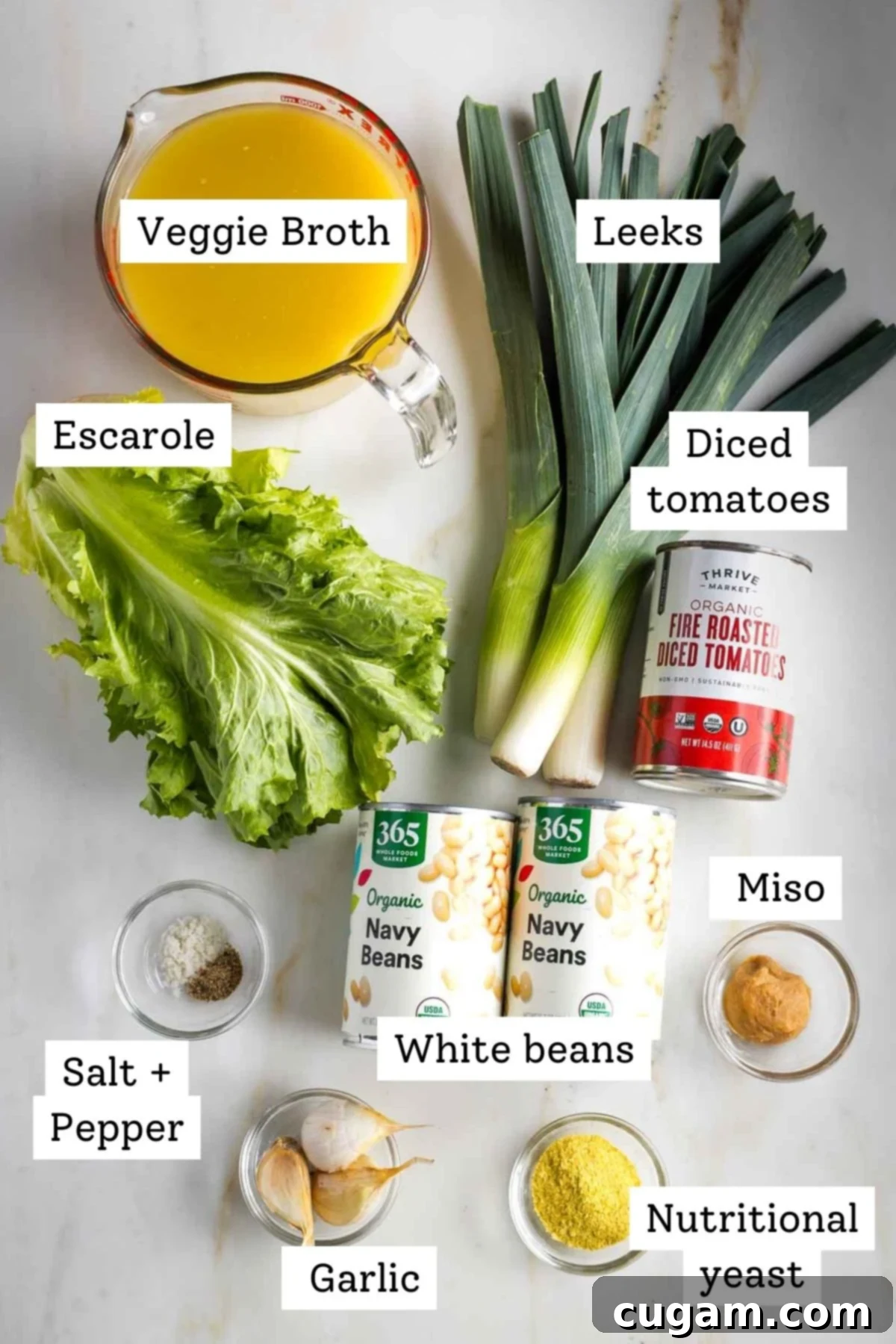
- Leek: Leeks provide a mild, sweet oniony flavor that softens beautifully when sautéed, forming a wonderful aromatic base for the soup. If leeks aren’t available, you can easily substitute with one large yellow onion, any sweet onion variety, or even a couple of shallots for a slightly more delicate flavor.
- Escarole: I highly recommend using a whole head of fresh escarole for its unique, subtly bitter, and slightly peppery taste, which mellows wonderfully during cooking. It adds both flavor and fantastic texture to the soup. If fresh escarole is hard to find, you can substitute with other bitter greens like mustard greens, or any leafy greens you prefer such as collard greens, lacinato kale (also known as Tuscan kale), regular green kale, or Swiss chard. Just make sure to roughly chop them before adding. For a quicker wilting option, spinach can also be used, but reduce the simmer time to about 5 minutes.
- Diced Tomatoes: Canned diced tomatoes, including their juices, contribute a lovely acidity and rich tomato flavor, adding depth and color to the broth. For an alternative, use canned whole tomatoes and chop them yourself for a slightly chunkier texture. When fresh cherry tomatoes are in season, halving them and adding them to the soup can offer a burst of fresh flavor.
- White Beans: Canned white beans are the secret to making this a lightning-fast one-pot meal. They’re already cooked and ready to go, saving significant time. Great options include cannellini beans (my personal favorite for their creamy texture), great northern beans, or navy beans. Remember to rinse and drain them thoroughly before adding to reduce excess sodium and remove the canning liquid.
- Vegetable Broth: The quality of your broth truly impacts the final flavor of your soup. I strongly encourage you to try my easy recipe to make your own homemade vegetable broth, which I often store in 1-cup frozen cubes for ultimate convenience. If you opt for store-bought broth, always read the ingredient label carefully. Choose a low-sodium option without added processed oils or unnecessary artificial ingredients to ensure the cleanest, healthiest flavor base.
- Miso: I use light miso, also known as white miso, and it’s a game-changer for vegan soups. It imparts an incredible umami flavor that adds complexity and richness, making a chicken stock base completely unnecessary. Miso brings a savory depth that can truly elevate your plant-based dishes. I rely on miso for this same flavor boost in my Vegan Split Pea Soup, showcasing its versatility. Remember to dilute it with warm water before adding to ensure it integrates smoothly without clumping.
- Nutritional Yeast: This magical ingredient is a staple in vegan cooking, offering a cheesy, savory flavor that’s hard to beat. It’s also packed with B vitamins. Adding it at the end enhances the soup’s umami profile and adds a lovely depth of flavor without any dairy. Don’t skip it if you want that subtle, comforting “cheesy” note!
Step-by-Step Guide: Crafting Your Delicious White Bean Escarole Soup
This soup is remarkably straightforward to prepare, making it an ideal recipe for both novice and experienced cooks. Follow these simple steps to bring this comforting meal to life:
Preparation is Key: Before you begin cooking, ensure your escarole is thoroughly prepped. Wash the head of escarole as you would a head of lettuce, making sure to remove any dirt or grit between the leaves. Use a salad spinner to get out most of the excess water, or pat it dry with a clean kitchen towel. Wrap it loosely in a dish towel until you’re ready for the next step.
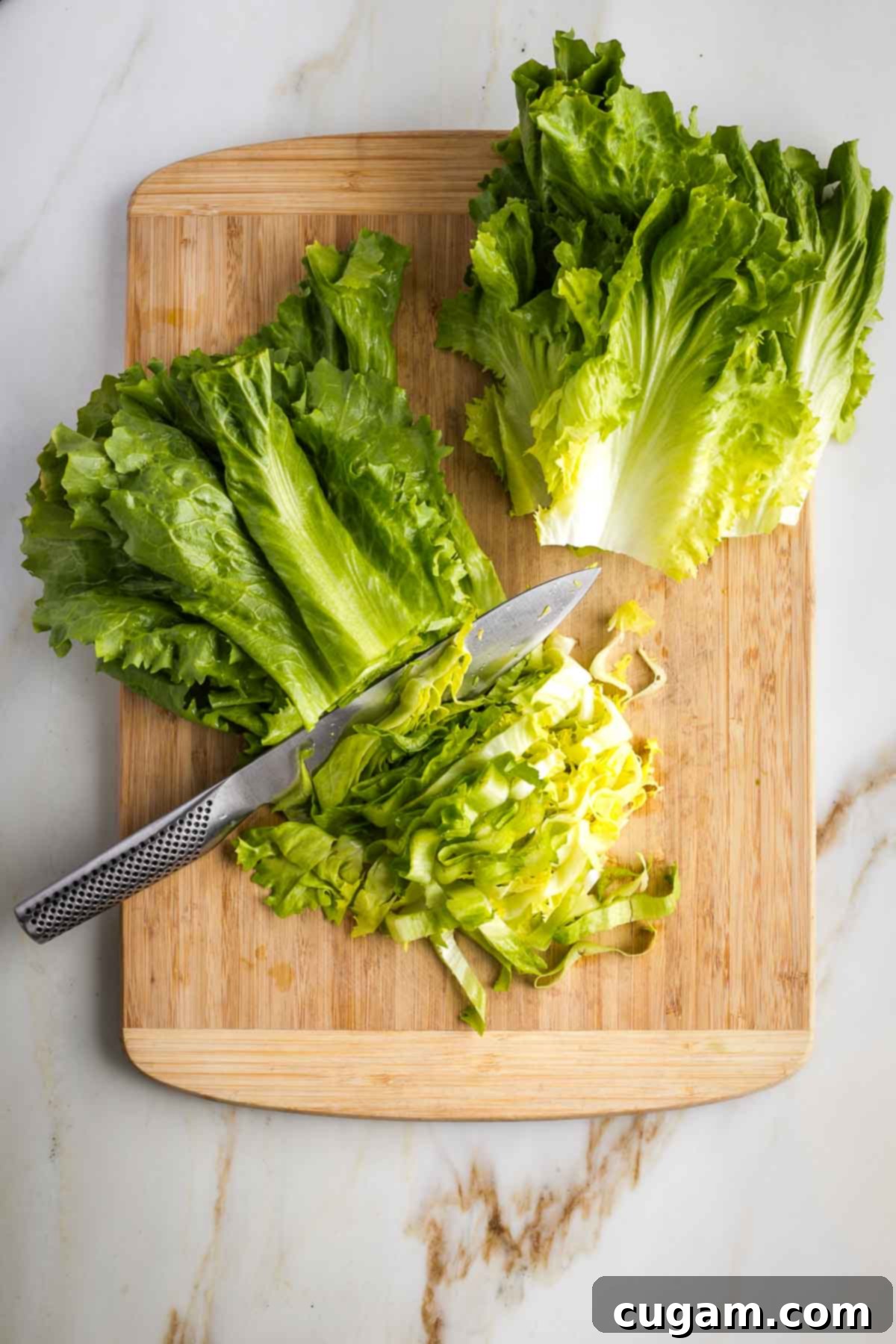
Once clean and dry, stack the escarole greens neatly. Then, using a sharp knife, slice through both the dark green outer parts and the lighter yellowish inner parts into rough, bite-sized pieces. You should end up with approximately 6 cups of firmly packed, chopped escarole, ready to be added to your soup.

Next, prepare your leeks. Start by trimming off the dark green fibrous tops and the root end. Slice the leeks lengthwise and wash them thoroughly under running water, fanning out the layers to ensure no dirt is trapped inside. Once clean, thinly slice only the white and the lighter green parts of the leeks. These parts are the most tender and flavorful for the soup.
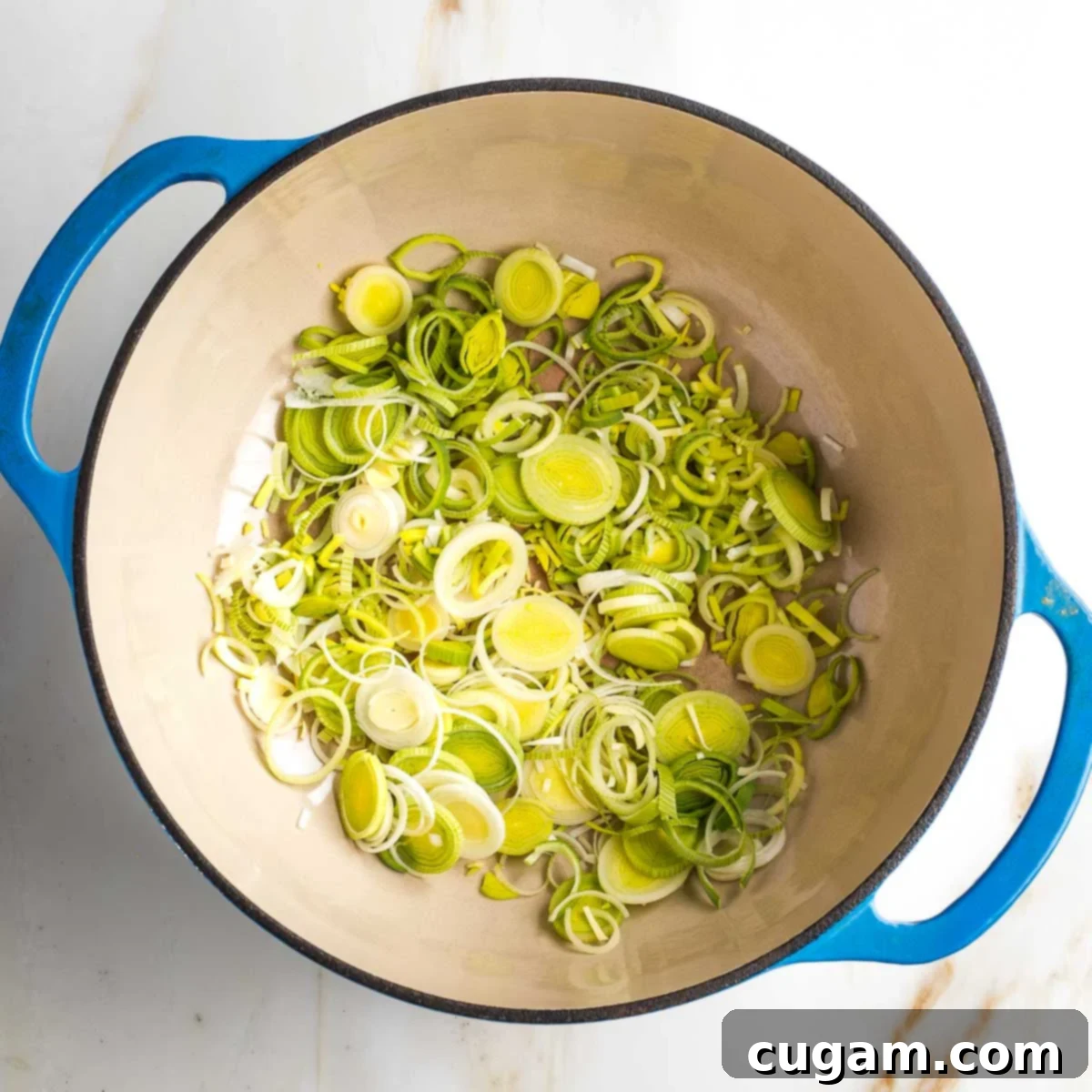
Place a large dutch oven or a sizable stockpot over medium heat. Add a couple of tablespoons of olive oil, or for an oil-free option, use vegetable broth. Once heated, add the thinly sliced leeks to the pot. Sauté the leeks for about 3 minutes, stirring occasionally, until they begin to soften and become translucent. This step is crucial for building the foundational flavor of your soup.
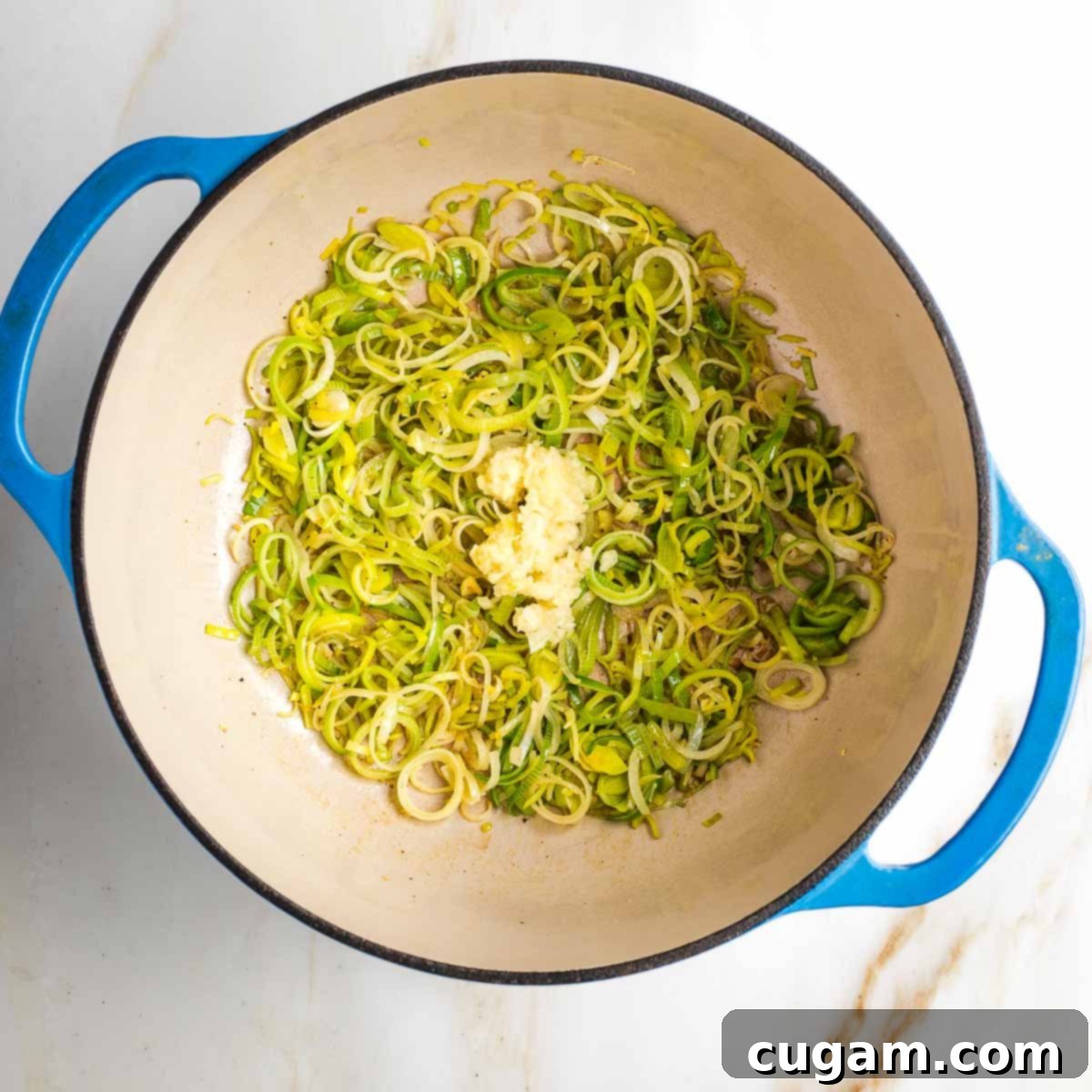
After the leeks have softened, use a garlic press to add the garlic cloves directly into the pot. Immediately sprinkle on the coarse sea salt and freshly ground black pepper. Cook for just 1 minute, stirring constantly, as the garlic becomes wonderfully fragrant. Be careful not to burn the garlic, as this can turn bitter and negatively impact the soup’s flavor.
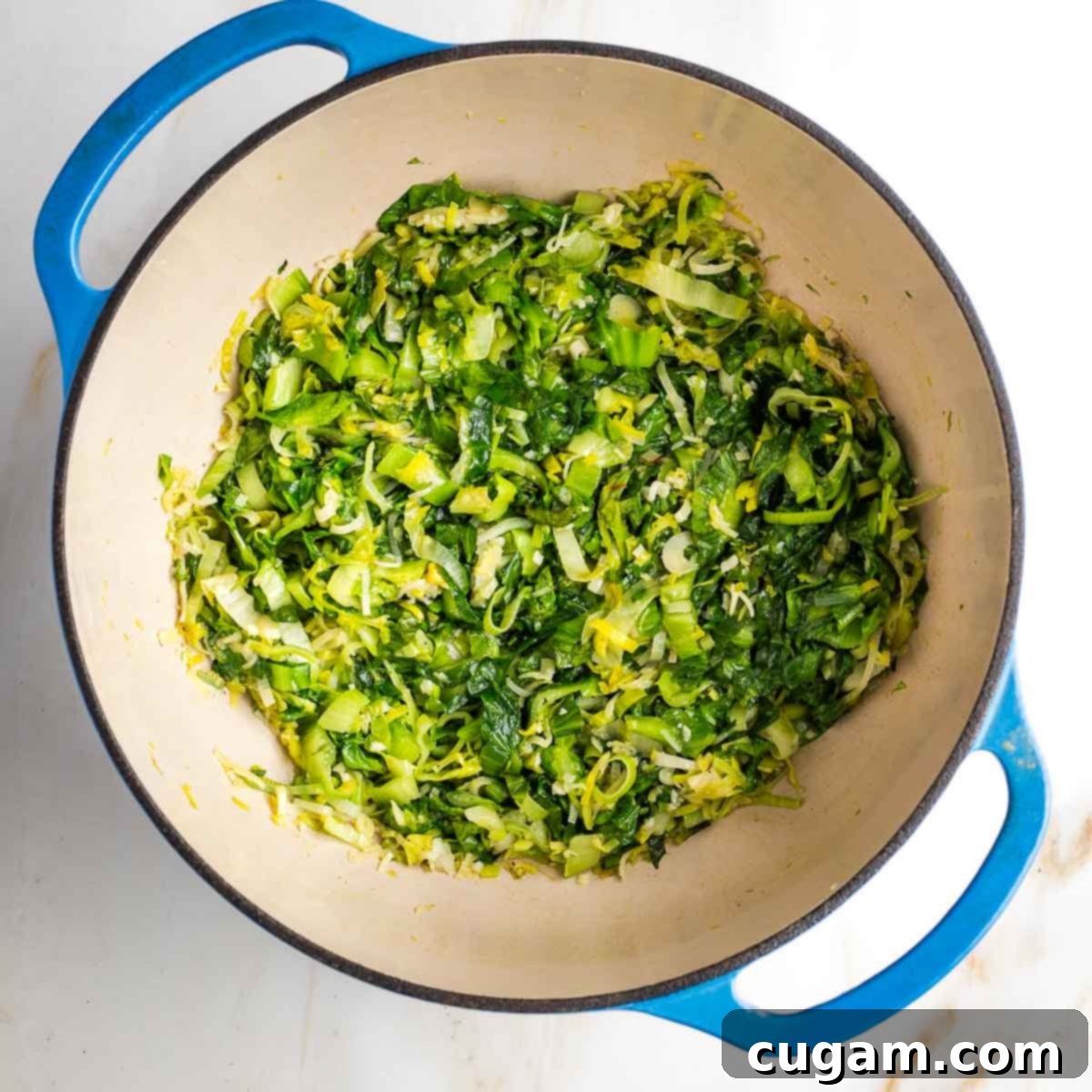
Now, stir in the roughly chopped escarole. It will look like a lot at first, but cook for about 2 minutes, stirring continuously, and watch as it quickly shrinks down and wilts into the pot. This tenderizing step ensures the escarole is perfectly integrated and easy to eat in the final soup.
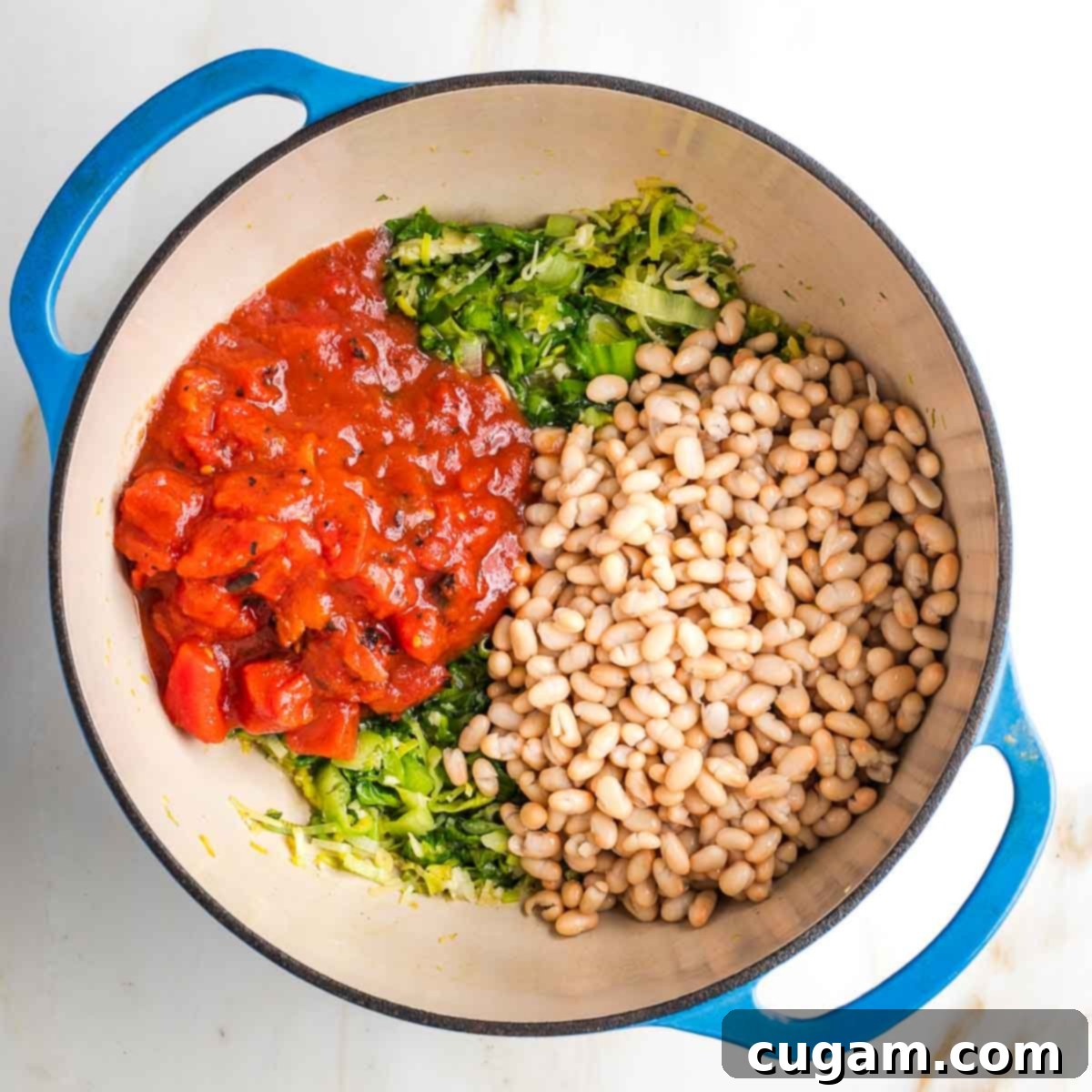
Next, add the canned diced tomatoes, making sure to include their delicious juices, and the white beans that have been thoroughly rinsed and drained. Give everything a good stir to combine all these fantastic flavors and textures evenly throughout the pot.
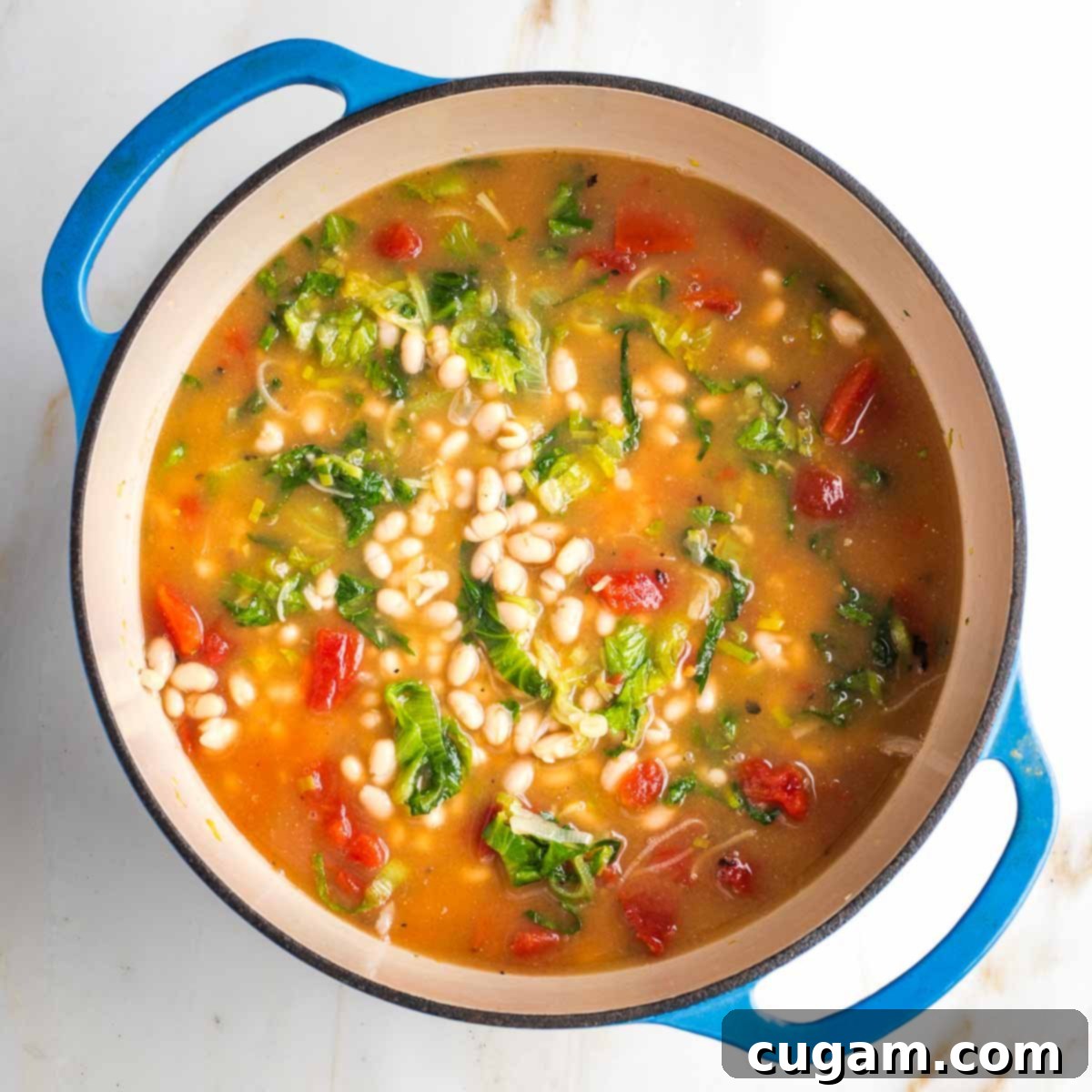
Pour in 4 cups of vegetable broth along with 2 cups of water. Stir everything thoroughly to ensure all ingredients are well-distributed. Increase the heat to medium-high to bring the soup to a rolling boil. This initial high heat quickly brings the liquids to temperature, activating the flavors.
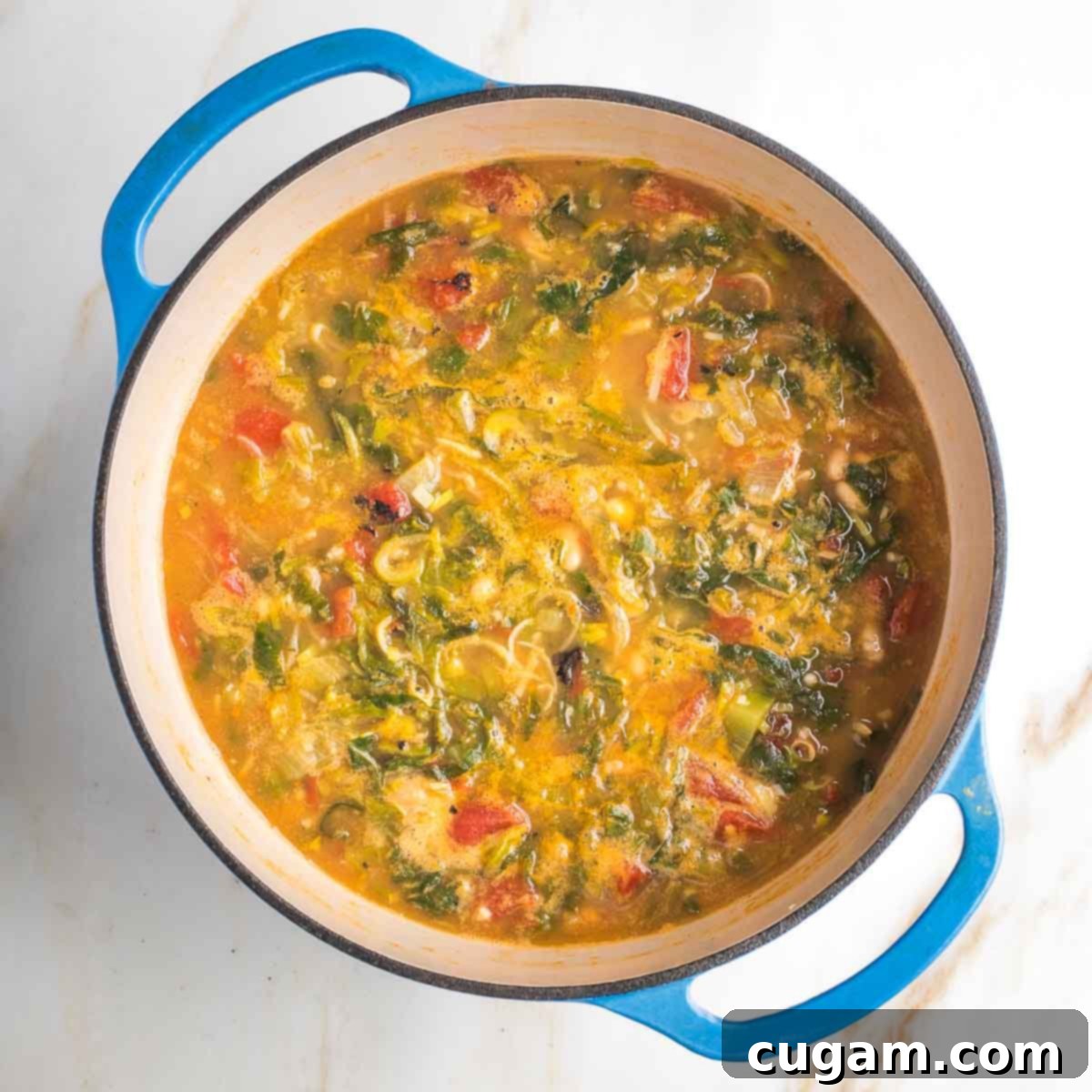
Once the soup reaches a boil, reduce the heat to medium-low. Allow the soup to maintain a gentle simmer for 10 minutes. This simmering time is crucial for the flavors to meld together beautifully and for the escarole to become perfectly tender. Stir occasionally to prevent anything from sticking to the bottom.

While the soup simmers, prepare your miso. In a small bowl or liquid measuring cup, whisk 1 tablespoon of light miso with ¼ cup of warm water until it forms a thick, creamy, and uniform consistency. This creates a “miso slurry,” ensuring it incorporates smoothly into the soup without any lumps. Adding miso at the end helps preserve its delicate flavor and beneficial probiotics.
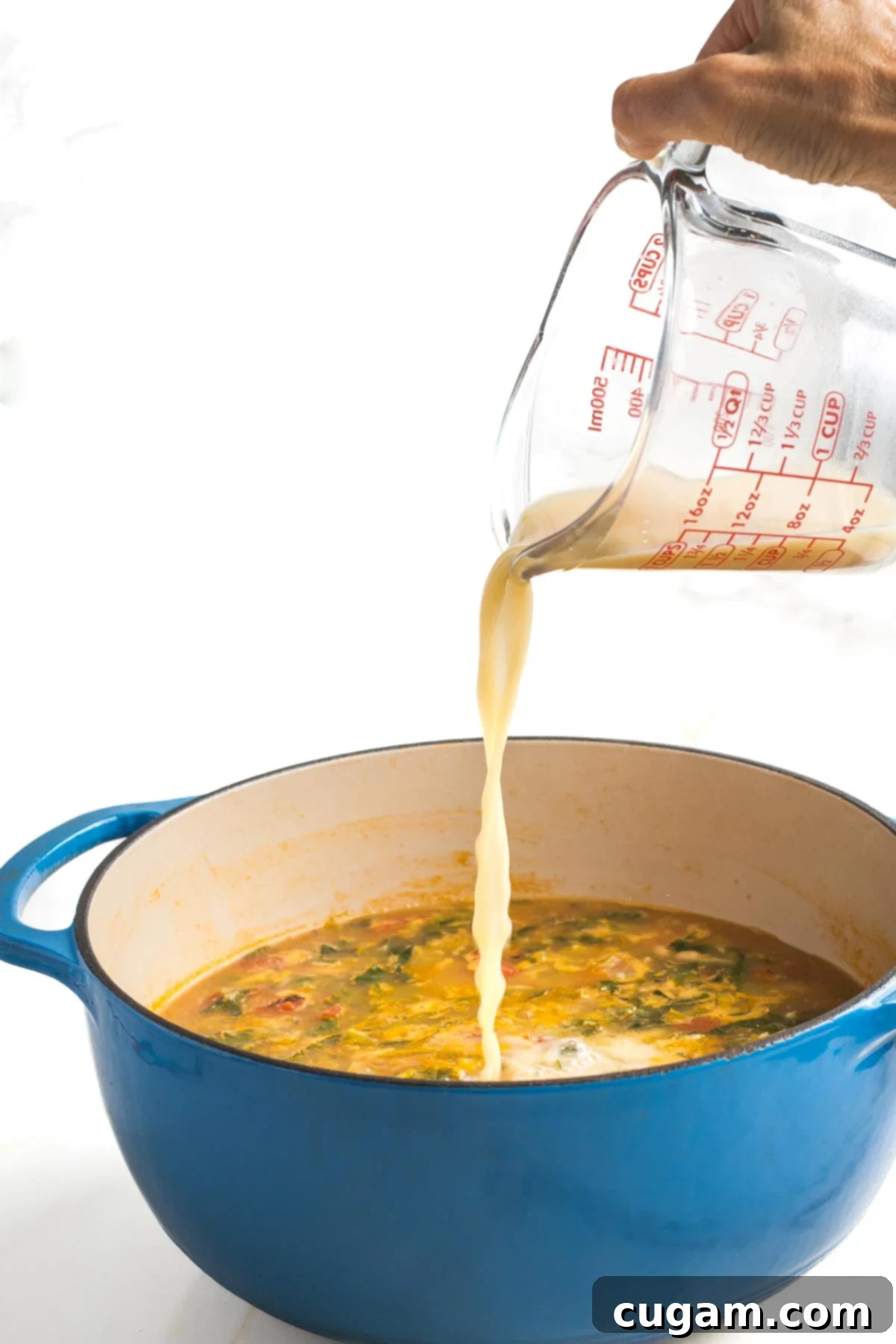
Carefully pour the whisked miso mixture into the soup. Stir it in thoroughly, ensuring it is completely combined with the broth. Allow it to heat through for just a minute or two, without bringing it back to a vigorous boil, to preserve miso’s nuanced flavor.
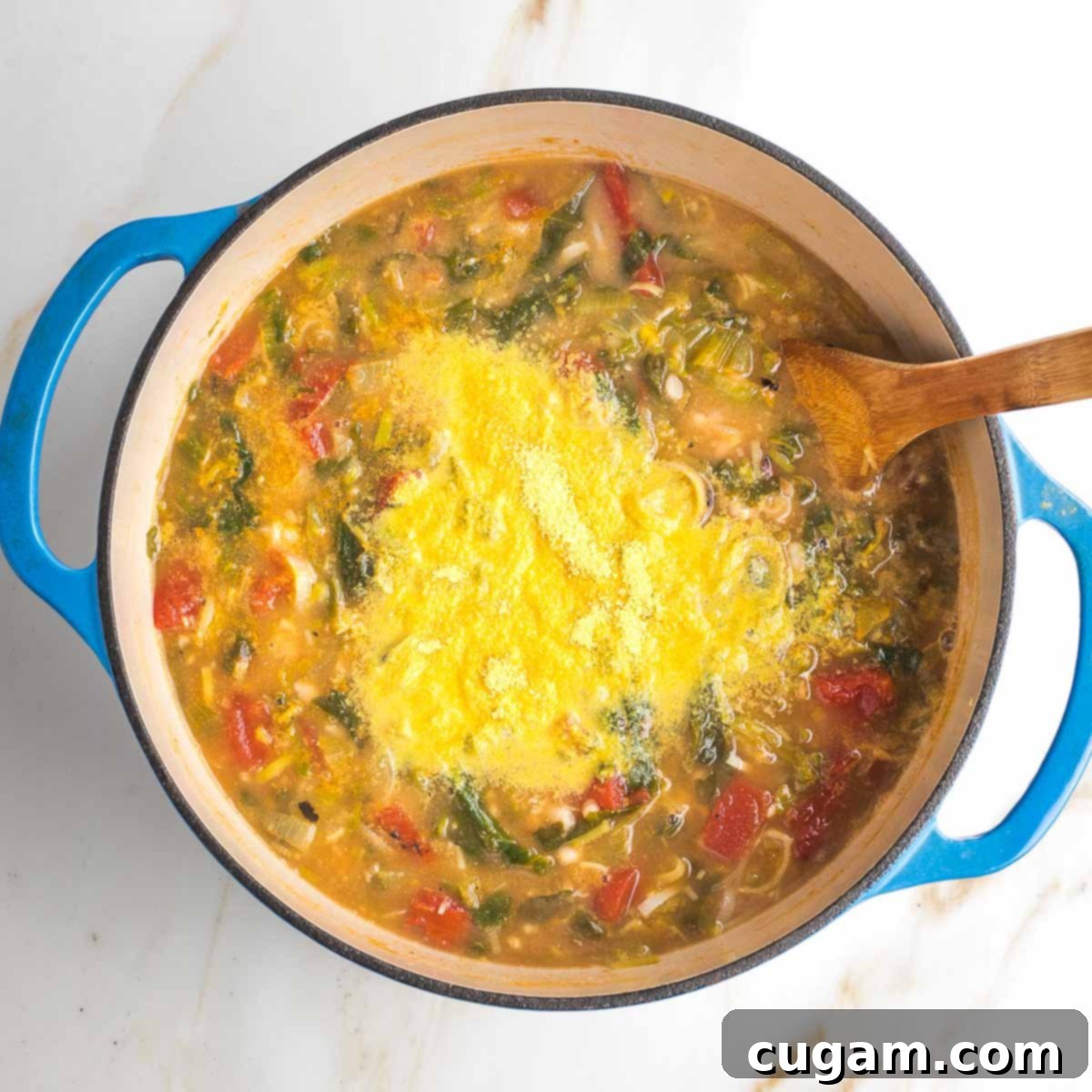
Turn off the heat. Now, sprinkle the nutritional yeast over the soup. This is where you get that wonderful, cheesy, umami boost. Mix it in thoroughly until it’s fully dissolved and integrated into the broth. The residual heat will be enough to incorporate it perfectly.
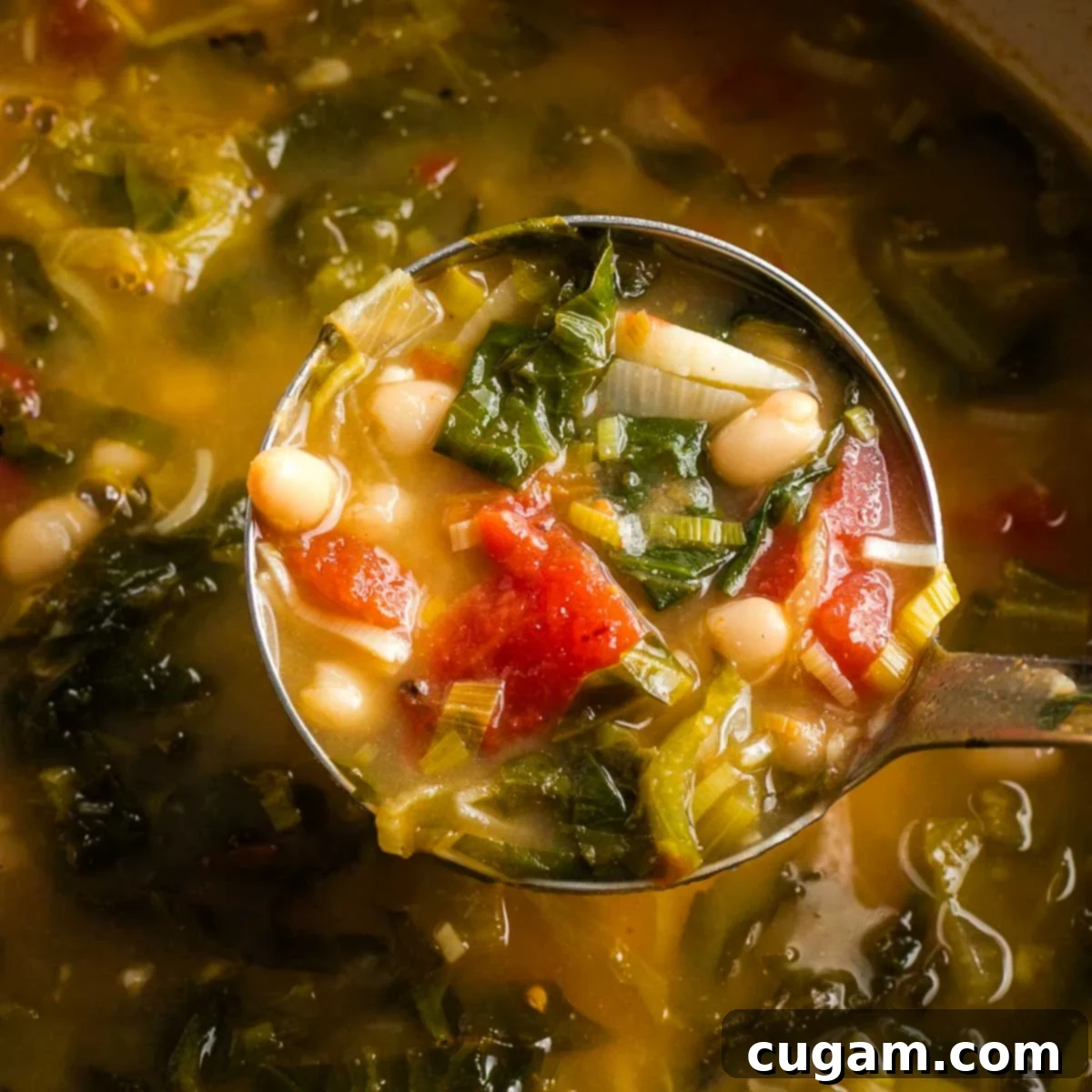
Your delicious White Bean and Escarole Soup is now ready! Ladle generous portions into individual bowls while it’s still piping hot. For an extra touch, you can garnish with a little more nutritional yeast or a pinch of red pepper flakes for a subtle kick.
Serving Suggestions and Storage Tips
Elevate your White Bean and Escarole Soup experience with these serving ideas and ensure its longevity with proper storage methods.
- Serving: This hearty soup is fantastic on its own, but truly shines when paired with a side. Serve it alongside warm garlic bread or a crusty Italian bread, perfect for soaking up every last drop of the flavorful broth. To make it a more substantial and complete vegan meal, consider adding a simple green salad like my Easy Green Salad with Capers or a creamy Vegan Kale Caesar Salad. A sprinkle of fresh parsley or a drizzle of good quality olive oil just before serving can also enhance its appeal.
- Refrigeration: Leftovers store beautifully! Transfer any cooled soup into an airtight container and keep it in the fridge for up to a week. The flavors often deepen and improve overnight, making it even more delicious the next day.
- Freezing: For longer storage, this soup is an excellent candidate for freezing. Allow the soup to cool completely before transferring it to freezer-safe containers or heavy-duty freezer bags. It can be stored in the freezer for up to 3 months. When ready to enjoy, simply thaw overnight in the refrigerator or gently reheat from frozen.
- Reheating: To reheat, transfer the desired portion to a saucepan and warm over medium heat, stirring occasionally, until heated through. If reheating from frozen, you may need to add a splash of vegetable broth or water to adjust consistency. Alternatively, microwave individual portions in a microwave-safe bowl, stirring halfway through.
Debra’s Pro Tips for the Best White Bean Escarole Soup
Unlock the full potential of your White Bean and Escarole Soup with these expert tips and tricks, ensuring a perfect bowl every time.
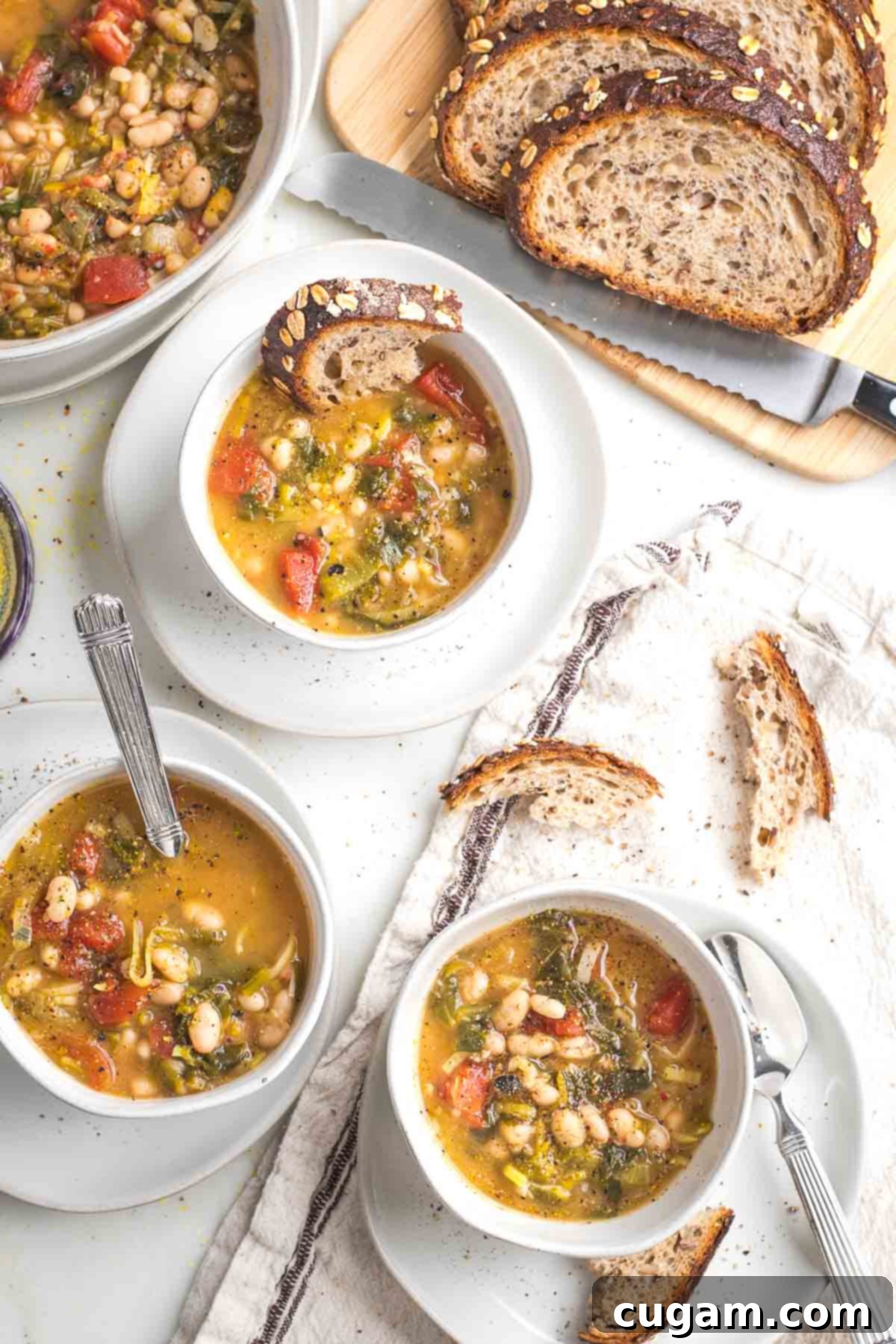
- Garnish for Flavor & Kick: Don’t underestimate the power of a good garnish! For an extra layer of flavor and a touch of heat, pass around a bowl of red pepper flakes and, crucially, more nutritional yeast. Trust me on this one: before you automatically reach for the parmesan cheese, give the “nooch” (nutritional yeast) a try! Its savory, cheesy flavor is incredibly satisfying and keeps the soup entirely vegan.
- Perfect for Meal Prep: This soup is an absolute winner for meal prepping. Make a large batch at the beginning of the week, and you’ll have delicious, healthy lunches ready to go. Simply heat a thermos with boiling water, empty it, then pour in your hot soup to take to work for a satisfying and nourishing midday meal. It stays warm for hours!
- Embrace Bitter Greens: This escarole recipe is a delicious and surprisingly approachable way to incorporate beneficial bitter greens into your diet without the overwhelming bitterness some people find challenging. The cooking process mellows its flavor beautifully. Escarole is also incredibly versatile; you can use it in any salad that calls for romaine or arugula, adding a sophisticated twist.
- Mise en Place for Speed: This is truly one of the easiest soup recipes and comes together remarkably quickly. To ensure a smooth cooking process and minimize stress, have all your ingredients prepped and measured before you even start heating the pot. This “mise en place” approach will make the cooking experience even more enjoyable and efficient.
- Adjust Seasoning: Always taste your soup before serving and adjust the seasoning as needed. Sometimes a little extra salt or pepper, or even a squeeze of fresh lemon juice at the end, can brighten all the flavors.
- Thicker Consistency: If you prefer a slightly thicker soup, you can mash some of the white beans against the side of the pot with the back of your spoon or use an immersion blender to briefly blend a small portion of the soup before adding the miso and nutritional yeast. This will release some of the starch from the beans and create a creamier texture without needing any cream.
Explore More Delicious Vegan White Bean Recipes
If you’ve fallen in love with the versatility and nutrition of white beans in this soup, you’ll be thrilled to discover how well they perform in a variety of other vegan dishes. Here are some more fantastic recipes featuring these wholesome legumes:
- Vegan Nicoise Salad
- White Bean Vegan Blondies
- Vegan Chicken Salad Recipe
- Easy Vegan White Bean Dip with Garlic and Herbs
Did you know commenting and rating recipes is one of the best ways to support your favorite food bloggers? If you made this recipe, please consider a five-star rating below and leave a comment. Also, please share your photos on instagram by tagging me @dkhealthcoach and using the hashtag #debraklein
📖 Recipe

White Bean and Escarole Soup
Debra Klein
33 votes
Rate this Recipe
Pin Recipe
8 minutes
20 minutes
28 minutes
Soup
American, Italian
4
105
kcal
Equipment
-
Dutch oven
-
Garlic press
Ingredients
-
3
leeks
thinly sliced (whites and light green parts only) -
½
teaspoon
coarse sea salt -
¼
tsp
black pepper -
3
large cloves
garlic
pressed or minced -
1
head
escarole
washed, dried, and roughly chopped (about 6 cups packed) -
1
(14.5-oz) can
diced tomatoes
with their juices -
4
cups
vegetable broth
(low sodium preferred) -
2
cups
water -
2
(15-oz) cans
cannellini beans
rinsed and drained -
1
tablespoon
light miso
diluted with ¼ cup warm water -
1
tablespoon
nutritional yeast
(plus more for serving)
Instructions
-
Wash and dry the escarole thoroughly, then roughly chop it. Next, prepare the leeks by trimming the ends, washing them well, and thinly slicing only the white and light green sections.
-
Heat a dutch oven or a large soup pot over medium heat. Add 1-2 tablespoons of olive oil (or vegetable broth for an oil-free option) and sauté the sliced leeks for about 3 minutes until they begin to soften. Sprinkle with salt and pepper, then add the pressed garlic, stirring constantly for 1 minute until fragrant.
-
Stir in the chopped escarole. Cook for approximately 2 minutes, stirring frequently, as the greens will quickly wilt and reduce in volume.
-
Add the canned diced tomatoes (with their juices), the rinsed and drained cannellini beans, vegetable broth, and water to the pot. Stir all the ingredients well to combine.
-
Increase the heat to medium-high and bring the soup to a boil. Once boiling, reduce the heat to medium-low to maintain a gentle simmer. Let it simmer for 10 minutes to allow the flavors to deepen and meld.
-
While the soup simmers, whisk the light miso with ¼ cup of warm water until smooth. Pour the miso mixture into the soup and mix well until fully incorporated. Allow it to heat through gently for a minute or two, but do not boil after adding miso.
-
Turn off the heat. Sprinkle the nutritional yeast over the soup and thoroughly mix it in. Ladle the hot soup into bowls immediately and serve.
-
Garnish with additional nutritional yeast and a pinch of crushed red pepper flakes if you enjoy a little heat.
Notes
Escarole: One head of escarole, once washed, dried, and roughly chopped, will give you about 6 cups firmly packed. This quantity wilts down significantly. For substitutions, you can use other sturdy leafy greens such as lacinato kale, green kale, collard greens, or Swiss chard; just ensure they are roughly chopped. For a less bitter profile, endive or Napa cabbage can also work well. If opting for delicate spinach, note that it cooks much faster, so reduce the simmer time for the soup to about 5 minutes after adding the spinach to prevent it from becoming mushy.
Nutrition
Calories:
105
kcal
Carbohydrates:
20
g
Protein:
5
g
Fat:
2
g
Saturated Fat:
0.2
g
Polyunsaturated Fat:
0.4
g
Monounsaturated Fat:
1
g
Sodium:
487
mg
Potassium:
524
mg
Fiber:
7
g
Sugar:
5
g
Vitamin A:
3555
IU
Vitamin C:
15
mg
Calcium:
101
mg
Iron:
3
mg
Note
The nutrition calculations were done using online tools and are estimated values. To obtain the most accurate representation of the nutritional information for this or any given recipe, you should calculate the nutritional information with the actual ingredients you used. You are ultimately responsible for ensuring that any nutritional information provided is accurate, complete, and useful for your dietary needs.
Did you make this recipe?
Please leave a review below, then snap a picture and tag me @dkhealthcoach or use hashtag #dkhealtcoach on Instagram so I can see it!!
